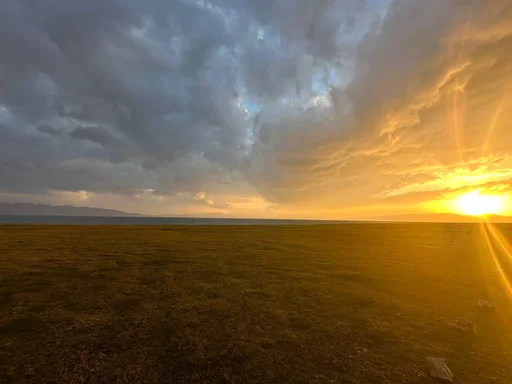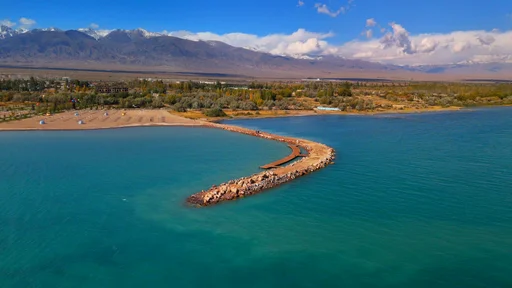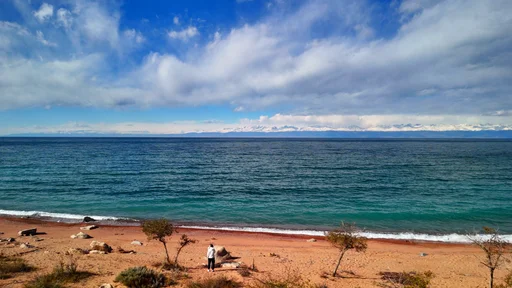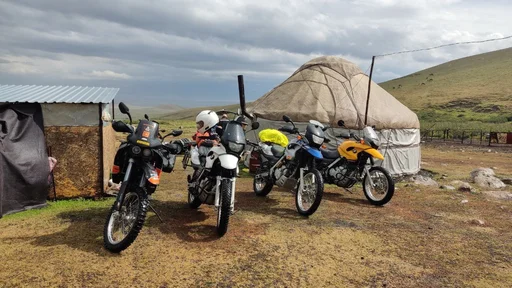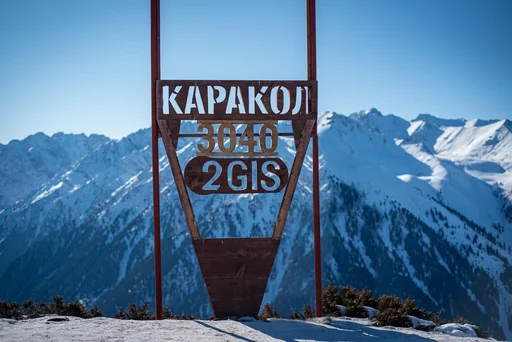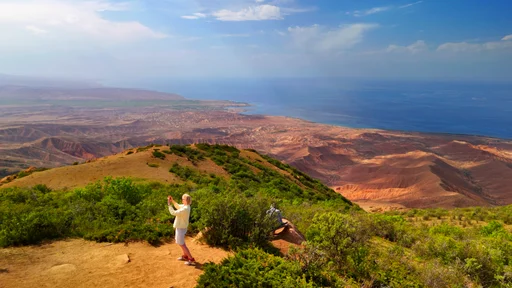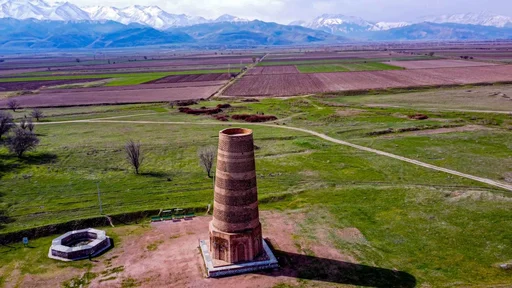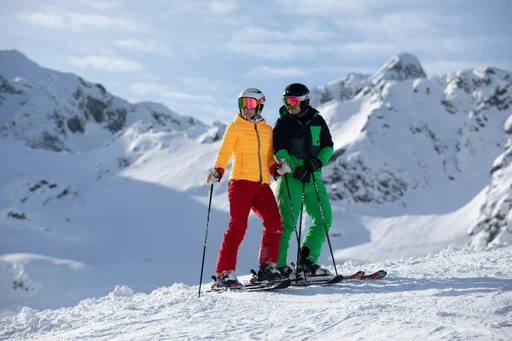Geographical Location and Climate
Son-Kul Lake (Kyrgyz: Соң-Көл, meaning “Last Lake”) lies in the very heart of the Inner Tien Shan, in the northwest of Kyrgyzstan’s Naryn Region. It stretches across a high-altitude plateau between the Sonkul-Too and Moldo-Too ranges at an elevation of about 3,016 meters above sea level. In size, Son-Kul ranks second in the country after Issyk-Kul: the lake covers approximately 278 km², reaching about 28 km in length and 18 km in width. Its shoreline extends for tens of kilometers, and maximum depth estimates range from 14 to 22 meters. Despite its considerable size, Son-Kul’s water is fresh - it is Kyrgyzstan’s largest natural freshwater body, fed by mountain streams and draining into the Naryn River system.
The climate around the lake is sharply continental and harsher than in the lowlands. Winter is long and cold: from late September to May, Son-Kul is covered by solid ice. Winter air temperatures drop to –20°C and below, and deep snow makes all roads impassable. The summer season is very short - practically only July and August - but even then it is much cooler than in the valleys. Daytime temperatures rarely exceed +15°C, and nights can fall to zero or below. Summers are sunny but changeable: sudden wind gusts, rain, and even snow are possible. The average water temperature in midsummer rises only to +11°C, making swimming a brief pastime for the hardy. Overall, the tourist season runs from mid-June to early September, beyond which the lake is essentially inaccessible.
Nature: Landscapes, Flora, and Fauna
Son-Kul is renowned for its pristine landscapes. The lake lies like a turquoise bowl amid green summer pastures and snow-capped mountains, creating striking natural contrasts. On clear days, the water reflects the sky in deep blue tones, yet its hue shifts with lighting - at times shining steel-gray, at dawn taking on violet hues, and glowing gold at sunset. The treeless shores offer 360-degree views: alpine meadows dotted with bright flowers stretch in every direction. Here one can find entire fields of edelweiss - rare star-shaped alpine flowers listed in the Red Book. Though the basin lacks tall trees, its turf hosts numerous medicinal mountain herbs that locals harvest and brew into healing teas. In summer, the hillsides around the lake are carpeted with fragrant grasses and flowers, creating a picturesque oasis amid the stark mountain terrain.
Son-Kul’s fauna is rich in mountain and aquatic species. The lake and its surrounding wetlands are home to dozens of bird species. From May to September, 66 species of waterfowl, including 14 species of ducks, nest or stop over here during migration. On the calm waters, one may spot rare Red Book inhabitants such as the Ruddy Shelduck and the Bar-headed Goose, while the shores host Demoiselle Cranes, Black Storks, Whooper Swans, and other rare birds. Not by chance was Son-Kul designated a Ramsar wetland of international importance in 2011 - this region is vital for protecting migratory birds. Among mammals, mountain predators and steppe dwellers roam nearby. Snow leopards and Turkestan lynx have been recorded in the surrounding mountains, and foxes and wolves may appear along the shores. Historically fishless due to the cold climate, the lake was stocked with valuable species in the 1950s. Today, Son-Kul supports whitefish (lake salmon), peled, osmans (scale and bald), and marinka - species all introduced after 1959. Thanks to the absence of industry, the lake’s ecosystem remains pure: the water is clear and oxygen-rich, and only grazing domestic animals and wild birds dot the shores.


Lake Origin and Hydrology
Son-Kul has an ancient geological origin. Scientists believe the lake basin formed due to tectonic processes - faults and subsidence of the Earth’s crust between Tien Shan ridges. Later, during the glacial period, this depression was smoothed and filled with glacial meltwater, creating a large high-mountain lake. Thus, Son-Kul is a tectono-glacial lake: its bed is shaped by crustal movements, and its historical supply came from melting glaciers. Today, up to 18 small rivers and mountain streams flow into the lake from surrounding ranges. Despite its high altitude, Son-Kul has an outlet: from its northeast end flows the Son-Kul River (also called Sonköl), which cuts through mountain gorges before joining Kyrgyzstan’s largest river - the Naryn. This outflow prevents water stagnation and mineralization, keeping the lake fresh and oxygenated. The hydrological regime is seasonal: water levels rise in warm months from snowmelt and freeze into an ice crust tens of centimeters thick in winter.
Nomadic Culture and Ethnographic Significance
The shores of Son-Kul have long served as summer pastures for nomadic herders. As soon as the mountain snow recedes and lush grasses sprout, shepherds (chabans) arrive with large flocks of sheep, herds of horses, and yak herds. From June onward, traditional yurt camps - dozens of white felt yurts - dot the green pastures. Here, on the high-altitude jailoo (summer pasture), chaban families live for months, grazing livestock on rich alpine meadows. This way of life has changed little over centuries: inside yurts, meals are still cooked on hearths, and dried dairy curds (kurt) are stored. Nomadic culture is vividly represented in daily life: men herd animals on horseback by day, youth compete in traditional games, and women craft felt rugs and cheese from July’s milk. In the evenings, shepherds gather in yurts, singing folk songs to the komuz (three-stringed lute) and passing down legends of their homeland.
Son-Kul is central to the identity of local Kyrgyz communities. For centuries, the lake valley has been a crossroads for nomads from various regions: herders from Kochkor, Naryn, and At-Bashy traditionally drove their livestock here. Each clan held grazing rights around the lake, passed down through generations. Summer gatherings fostered exchange of news, goods, and cultural traditions among distant mountain tribes. Today, tourists at Son-Kul can immerse themselves in authentic nomadic life. Guests may stay overnight in a yurt with shepherds, enjoying national dishes - from freshly cooked lamb to hot tandoor bread. In the morning, they awake to birdsong and the bleating of sheep, watching as their host saddles a horse to check the herd. Such first-hand encounters with nomadic hospitality make Son-Kul not only a natural but also a cultural treasure of Kyrgyzstan.
History and Legends of Son-Kul
Evidence of human presence around Son-Kul dates back millennia. Although no permanent settlements existed at such elevations, archaeological finds show people visited here from ancient times. Petroglyphs in the lake’s vicinity, likely created by Bronze Age nomads and later by Turkic tribes, depict hunting scenes, mountain goats, and horsemen - proof that Son-Kul’s alpine pastures were used for herding and rituals centuries ago. Burial mounds and campsite remains of ancient tribes attest to seasonal use of these highlands. With the spread of Islam and later Russian imperial rule, nomadic traditions persisted - every summer the valley thrived, only to be deserted again by winter’s onset.
Many legends surround Son-Kul, passed down through generations. One tells of a cruel khan who once had a grand palace here and a large harem. His oppressive rule so outraged the mountains that the earth opened and swallowed his palace and treasures. The empty valley filled with spring waters, forming Son-Kul. Thus, legend says, the lake was born as a reminder of the tears and fates of innocent women and as punishment for the khan’s arrogance. Another legend links the name “Last Lake” to a tale of a grieving maiden: upon learning of her beloved’s death, her final tears filled the basin, creating the lake. They say Son-Kul’s waters remain clean and clear because they are the gift of sincere emotion. While these are poetic tales, they reflect locals’ deep reverence for their lake.
More recent history has also left marks on Son-Kul’s shores. On the northern shore stands the mausoleum of Taylak Batyr - the only stone structure in the valley. Taylak (Taylak Batyr), a folk hero of the late 18th–early 19th centuries, fought against Kokand and Qing invasions. He died young, and in the late 19th century, grateful descendants built a domed mausoleum (gumbaz) over his winter camp. Nearby rests his comrade and brother Atanai - together symbolizing the Kyrgyz struggle for freedom. Today, the mausoleum draws tourists and pilgrims, reminding visitors that this remote corner preserves important chapters of history. Close by lies the modern village of Kok-Oy, known for the “Emel” mineral spring, often likened in composition to Georgia’s famous Borjomi. Thus, Son-Kul captivates with both natural beauty and cultural-historical monuments that preserve this land’s past.
Tourism: Routes, Trekking, and Yurt Camps
Today, Son-Kul is a popular ecotourism and adventure destination. Each year, from June to early autumn, dozens of yurt camps for visitors spring up along the shores - from the simplest to more comfortable setups catering to foreigners. The infrastructure remains eco-oriented: no permanent buildings, only portable yurts and tent camps to preserve the natural landscape. Tourists come to Son-Kul to experience wild nature far from civilization and enjoy majestic scenery. Staying in a lakeside yurt is a unique experience: by day, one can ride horses across vast meadows, watch eagles soar, and by night, warm by the hearth while gazing at the star-studded sky. Nights are cool, but traditional yurts retain heat well, with felt walls and many equipped with wood stoves. Camps serve fresh local produce - lamb, dairy delicacies, and mountain herb tea. A special treat is trying fish caught directly from the lake, such as fried whitefish, or joining fishermen for early-morning angling.
The journey to Son-Kul is itself an adventure and attraction. Several scenic routes lead to the lake, each crossing high passes with breathtaking panoramas. The most common route approaches from Kochkor via Kalmak-Ashuu Pass (3,446 m): drivers crest a ridge to a sudden view of the lake’s turquoise mirror framed by peaks. An alternative route climbs Teskey-Torpok Pass (3,133 m), nicknamed “33 Corners” for its numerous hairpin bends. Descending this road, travelers can stop at the Kazhyrty Waterfall at the base - small but picturesque streams fed by snowmelt. From the south, a road via Moldo-Ashuu Pass (~3,200 m) leads to the lake’s southern shore - often used by herders from Naryn. Regardless of route, the last kilometers run across rolling hills before revealing the vast lake - an unforgettable sight.
The Son-Kul region offers many activities for outdoor enthusiasts. Trekking and horseback routes appeal to those wanting to hike to the lake through mountains. A classic trek from the Kochkor valley follows a scenic gorge to the lake’s western shore. Another path from the village of Kyzart crosses the Kilemche pasture and Tuz-Ashuu Pass before descending to the shore. Such multi-day treks showcase remote wilderness. Guided horse tours lead tourists on multi-day rides, spending nights in nomadic yurts. Around the lake, visitors can hike up nearby hills for spectacular lake and peak views. Swimming in Son-Kul’s icy water is for the brave, but most savor dipping their feet after a long trek. Summer evenings find visitors by campfires on the shore, soaking in the spectacular sunset painting the mountains and water in rosy hues.
How to Reach Son-Kul
Son-Kul is only accessible in the warm season - from late spring to early autumn when passes are open. Most journeys begin in Bishkek, about 280-300 km southeast of the lake. The main route follows a well-paved highway to Naryn (via Kochkor or Suusamyr Valley), but the final tens of kilometers are over a gravel road across mountain passes. In dry summer weather, even a regular car can manage this stretch, but many prefer all-wheel-drive vehicles or book a jeep tour for safety amid rain and mud. Travel time from Bishkek is about 6-7 hours, and from Naryn roughly 3-4 hours. From the northern shore to nearby villages (e.g., Chaek in Jumgal Valley) adds several hours on rural roads.
Note that Son-Kul roads close in winter due to snow and ice. From October to May, passes are snowbound and dangerously cold. The lake is effectively cut off - no regular transport operates, and even local herders leave until summer. In theory, winter access is possible by skis, snowmobile, or horseback, but such expeditions are rare. Thus, plan visits in peak summer. There is no public transport directly to the lake; one can take buses or taxis to Kochkor or Naryn from Bishkek, then hire a 4x4 with a driver. Many travelers use tour companies that organize group day trips including transfer, meals, and yurt camp stays - an easy way to experience Son-Kul’s beauty and return with unforgettable memories.
Ecology and Nature Conservation
Son-Kul’s environment is relatively undisturbed, and preserving it is vital. Part of the lake area falls within the Karatal-Japyryk State Reserve, established in 1994. The protected zone covers extensive mountain ecosystems and the lake’s 5,200 ha water surface. Its status as a reserve and Ramsar site attracts attention to preserving unique flora and fauna. International and domestic environmental groups monitor bird populations, snow leopards, and other rare species in the region. For years, Son-Kul supported fishing of introduced whitefish, but today fishing is minimized, and ecotourism and sustainable use are prioritized.
However, Son-Kul faces ecological challenges. In Soviet times, pasture intensification led to a DDT spraying incident in the 1970s to combat locusts; rain washed chemicals into the lake, killing fish and disrupting the ecosystem. Recovery took decades. Another issue was illegal gillnet fishing in the 1990s and 2000s. Abandoned nets became “ghost nets,” trapping fish and polluting the lake with lead from sinkers. Today, authorities and volunteers regularly remove old nets, but fish stocks remain lower than before. Additionally, growing tourism and summer yurt camps have increased human pressure: vehicle and livestock tracks trample vegetation, creating ruts and informal paths. Not all visitors or camp operators practice sufficient environmental care, leading to litter - bottle shards, plastics, and other waste that spoil the view and endanger wildlife.
To protect this unique site, measures are in place: restrictions on permanent construction, limits on yurt camp numbers, and visitor education on Leave No Trace principles. Local communities involved in tourism also work to keep the lake clean - some provide waste bins, organize trash removal, and inform guests about proper conduct. Son-Kul remains one of Kyrgyzstan’s premier ecotourism destinations, and it is crucial that tourism development goes hand in hand with nature conservation. By preserving its crystal-clear water, abundant birdlife, and pristine landscapes, Son-Kul will continue to inspire new generations of travelers.
Interesting Facts About the Lake
Altitude and Size Record: Son-Kul is not only Kyrgyzstan’s second-largest lake by area but also the largest high-altitude freshwater lake in the Tien Shan (3,016 m asl, 278 km²). In regional freshwater reserves, it ranks just behind salty Issyk-Kul.
Long Winter: In its high-mountain setting, Son-Kul freezes for over half the year - from October to May - forming ice up to a meter thick, sometimes strong enough for horseback travel by locals.
A Fishless Lake: Until the mid-20th century, Son-Kul had no fish due to its extreme cold. Only in 1959 did biologists stock it with whitefish, osmans, and other species. Today, it is known for its flavorful lake salmon.
Related News

